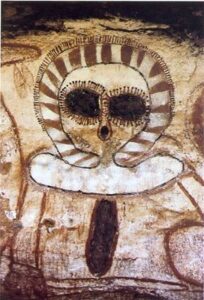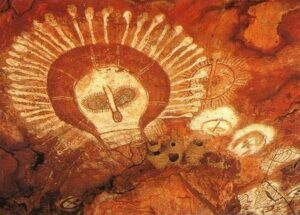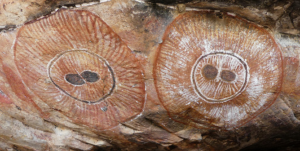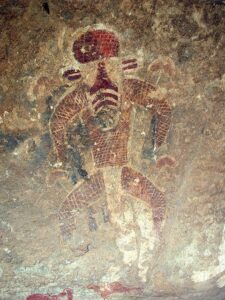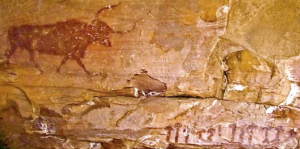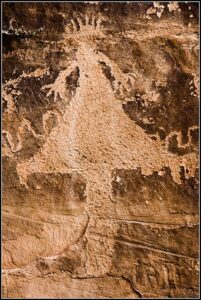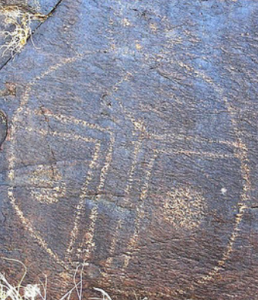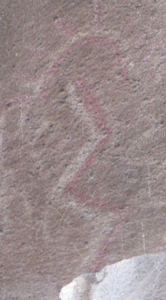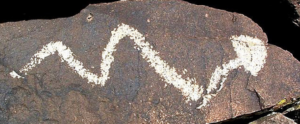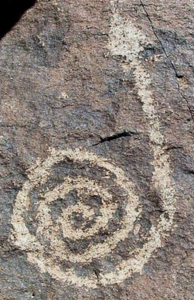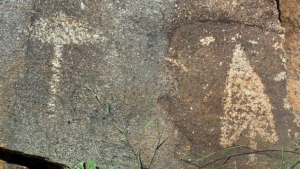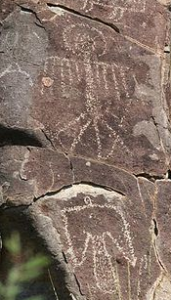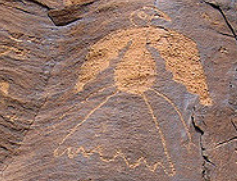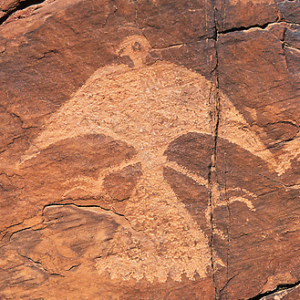“There is not so much evil in all this as you might suppose, and Providence will not permit the total destruction of that remnant of Philosophy which has escaped the lamentable shipwreck Truth has sustained.” (From Secret Sciences, 1670)
Chapter 1: In the Beginning Goddess Created….
The fact that the Bible uses the term “God,” as in “God created” should tell us something right away. The book was clearly written by a man, not a woman. Woman creates, not man. There is no such thing as a “creator god” and there never has been until the advent of patriarchy. The only thing men create sometimes, is a mess and usually women are the ones who have to clean it all up.
For too long now, the scale has been unbalanced, in favor of the patriarchy, and this book is a sincere attempt to correct that imbalance, in regard to religion, and even spirituality. This book, however, is not used to preach any such gospel. This book is about evidence.
There have been a number of arguments put forth for years about why the bible could not be true, or how Genesis could not have happened this way or that. I’m going to stay away from all of that controversy and put forth information that is known or believed with a high degree of certainty as to its truth. The truth is that nobody can say what God said or God did unless they were there at the time. What do we know about the ancient history of the human race? Let’s start right there.
Animals & Psychedelics
Primates have a natural inclination to find healing herbs and plants. One such case is the chimpanzees at Gombe Stream National Park in Tanzania. Primatologists studying these apes noticed, in the dung there was a species of leaf that was never digested and so they tracked this down to a tree that exists a short distance from their primary habitat. It seems every few days the chimps would walk over to this tree and place the leaves in their mouths, before swallowing it whole. They would eat as many as thirty small leaves in this manner.
Biochemist Eloy Rodriguez of the University of California at Irvine, then isolated the active ingredient from the Aspila, a reddish oil called thiarubrine-A. It was discovered by Neal Towers of the University of British Columbia that this kills bacteria in concentrations of less than one part per million and the chimps were consciously using this as a medicine or preventative. It was then realized that African people used Aspila leaves to treat wounds and stomachaches and it just so happens that out of the four species native to Africa, the chimps and the people both used the same three species only. Continued research by both Rodriguez and Towers have found roughly a dozen plants in use by the chimpanzee population for medicinal purposes of one kind or another. (1)
Animals have been using psychedelics probably since they first learned to eat. Somehow animals have a sense of what they can and cannot eat, and they appear to enjoy the use of mind-altering plants, not just for food, but for the purpose of which they were put on the planet for, to get mammals high. For instance, Alchornea floribunda is used by gorillas and A. cordifolia is used by chimpanzees. A floribunda is a source of the drug alan, a visionary intoxicant used by several West African tribes. The tribal people claim to have discovered the use of this plant as an entheogen by observing gorillas after eating the roots. This is also how the natives of the Bwiti religion in Gabon, Africa, know how to use Iboka, the root from which Ibogaine is derived. Ibogaine is a very effective root to take for breaking addiction cycles and has been shown to help in putting an end to cocaine and heroin addiction. (2)
Farmers and livestock breeders have often witnessed and been subjected to the whims of their animals who go looking to get high without “permission,” sometimes not returning for days. Mules, horses, cows, sheep, antelopes, pigs, rabbits and hens all seek out the plant called “locoweed,” also called “crazy-grass” or “crazy-seeds,” which represent about 40 different species of wild grasses. (3) Animals go crazy for locoweed and they have been caught stealing the sacks that farmers contain it in after cutting, to keep it from the animals, and they have also been caught overturning the wagons in which the sacks have been placed in order to get to the seed. Horses have been known to go crazy tripping and they dig up the roots to get to them while high, in a mania panic. (4) In Sumatra, tigers have been known to attack people carrying fermented durian fruit and then leaving the person alone, devouring the fruit instead. (5)
Squirrels and chipmunks seek out and enjoy the fly-agaric A. muscaria mushroom, nibbling at it and becoming intoxicated as do ordinary flies, which get “drunk” from the juice of the water that sits on the surface of the cap and mixes with the mushroom, and they fall over, only to recover later on and fly away. When goats discover a cluster of psilocybin mushrooms, they stop eating other grasses entirely until the mushrooms are all consumed, then run about awkwardly, shaking wildly and displaying characteristics of an animal clearly intoxicated. (6)
(1) Food of the Gods, The Search for the Original Tree of Knowledge, Terence McKenna, Bantam Book, 1993, p. 16)(E. Rodriguez, M. Aregullin, S. Uehara, T. Nishida, R. Wrangham, Z. Abramowsky, A. Finlayson, and G.H.N. Towers, “Thiarubrin-A, A Bioactive Constituent of Asilia (Asteraceae) Consumed by Wild Chimpanzees,” Experientia 41 (1985) 419-20.
(2) Samorini, Animals and Psychedelics, Page XII
(3) ibid, page 18, 19
(4) ibid, Page 23
(5) ibid, page 29
(6) ibid, page 42
Page 1
Insects know how to get high as well, as Georgio Samorini documents in his book, Animals and Psychedelics. So, if we ask ourselves “when did mankind first start getting high, the answer is a real mystery that only a handful of people have truly speculated on with sincerity, Terence McKenna being a primary candidate here. McKenna speculated that, from eating psychoactive mushrooms, humans then figured out… how to do things much faster and with better accuracy, developing certain parts of the brain, which led to the rapid changes that led to the building of civilizations. McKenna termed this the “stoned ape” theory. I think his words in this excerpt from Food of the Gods are valid and worthy of mention:
“The first encounters between hominids and psilocybin-containing mushrooms may have predated the domestication of cattle in Africa by a million years or more. And during this million-year period, the mushrooms were not only gathered and eaten but probably also achieved the status of a cult. But domestication of wild cattle, a great step in human cultural evolution, by bringing humans into greater proximity to cattle, also entailed increased contact with the mushrooms, because these mushrooms grow only in the dung of cattle. As a result, the human-mushroom interspecies codependency was enhanced and deepened. It was at this time that religious ritual, calendar making, and natural magic came into their own.” (7) I would say Terence and I are in agreement about the idea that Amanitas did not come before psilocybin in the order of familiarity to early mankind. Although I regard McKenna to be a profound pioneer and psychonaut, I have developed my own ideas, which all and all, for the most part, are not too much different, but differ in certain details significantly. I will present these at the end of the book. Let’s take a look at what we know, or what scientists, anthropologists, and archaeologists have determined, for the most part, to be true.
The Human Opiate and Endocannabinoid System
Endogenous morphines, or endorphins, make up the family of peptide chains which act as our body’s natural painkillers. (8) Endorphines exist in various parts of the brain and spinal cord and our brain has specific opiate receptor sites which pair perfectly to both the brain and plant alkaloids. (9) This means that the plant alkaloids are made for humans by nature, goddess, god or whatever you like to call it, the “great architect of the universe.”
Our bodies also have an endocannabinoid system full of cannabis receptors located throughout the body. These are involved in a variety of physiological processes including appetite, pain-sensation, mood, and memory. (10) Similar to opiates, our bodies are designed to interact with these plant molecules and substances. (11) Medicine has long known about the uses of both opiates and cannabis but it has not been in the pharmaceutical lobby’s interest to promote cannabis due to the possibility of it severely reducing opiate
dependency. The Catholic Church, Great Britain and the American pharmaceutical mafia have made untold hundreds of billions of dollars in profits by both the legal medicinal use and the black-market distribution of opiates. China has had a long history battling illegal markets introduced by the British since the 1800’s while opiate addiction keeps families of lower and middle classes trapped in endless cycles of poverty and disenfranchisement.
Cave People
What do we know about the earliest period of human food consumption?
About one and a half million years ago, australopithecine kitchen type areas for early man found that 92% of bone fragments were antelope, indicating a diet of mostly bovine animals and this diet is maintained through the fossil record up to the modern day. (12)
Zhoukoudian or Choukoutien is a cave system in suburban Fangshan District, Beijing. It has yielded many archaeological discoveries, including one of the first specimens of Homo erectus (Homo erectus pekinensis), dubbed Peking Man. This early hominid culture from 750,000 years ago had been making clubs, hand-axes, knives and scrapers and had the ability to work stone, bone, skin, and sinew from the period of approximately 670,000 years ago to 530,000 years ago. At this particular site, along with discarded animal bones, mostly deer, more than forty Homo erectus skulls were found as well. There were no body bones, only heads. All the heads had been crushed by blows and opened at the base to extract the brains. (13) At this point, it might be a good idea to withhold making assumptions about what they did with the brains. We simply do not know.
(7) Food of the Gods, 20
(8) AMA Encyclopedia of Medicine, Random House, 1989, p. 405
(9) Solomon H. Snyder and Steven Matthysse, Opiate Receptor Mechanisms: the MIT Press, 1975
(10) Aizpurua-Olaizola O, Elezgarai I, Rico-Barrio I, Zarandona I, Etxebarria N, Usobiaga A (January 2017). “Targeting the endocannabinoid system: future therapeutic strategies”. Drug Discovery Today. 22 (1): 105–110
(11) Russell, Shamanism and Drug Propaganda, p.7
(12) ibid, p.10; Raymond A. Dart, Adventures with the Missing Link: The Institutes Press, 1967, p.173
(13) ibid, p.11; Blanc, in Sherwood L. Washburn, Social Life of Early Man, Aldin Publishing, 1961, p. 133
Page 2
The Zhoukoudian caves as well as another site in Thailand have the oldest known hearths recorded. Charred bones from antler, charcoal and clay-baked floors have been found indicating a marked period of evolution. (14) We cannot be sure at what stage humans first used entheogens but they certainly appear to have been intelligent enough to use fire and cook by this time but they do not appear to be using entheogens yet. Was it because they were not intelligent enough to or capable of using their intellect in that way and another version of man needed to appear or be created first? This is a possibility, I suspect.
The Moon
The moon was undoubtedly one of the most influential celestial bodies upon the thought of early humanity. In all likelihood, it was the synchronicity of the moon with the female menstrual cycle that was first noticed by women. Accordingly, rites were developed around the menstrual cycle which likely coincided with rituals developed for the birthing process, all centered on the lunar cycles. (15)
The first engraving found in rocks and stone tools date from around 300,000 BC, supposedly the time Homo sapiens first developed (also known as the early Neanderthal period), what are called “moon-time markers.” (16) Thousands of stone and bone fragments have been unearthed dated to c. 30,000 BC, which have long and complex sequences of notches and scratches on them indicating a language or numbering system. Alexander Marshack, author of The Roots of Civilization, examined these markings under a microscope and found that the signs, which included grooves cut in various depths, widths and shapes, used a different tool at each new moon phase, as well as cuts in a new angle. A single piece of bone might record 6 months on one side and six months on the other. (17) These moon-time-sticks also appear in the hands of women and shamans in Paleolithic cave paintings from 50,000 BC.
Marshack spotted one of these more modern versions in an 1828 portrait of a Winnebago Chief which was 53 inches long, with four sides, or faces; “Vertical marks are etched into it at regular intervals; above them are small crescents and dots.” Marshack has found at least five calendar sticks from three different Native American tribes. (18)
A tablet discovered in an Upper Paleolithic site in Mal’ta, Siberia is said to be from 26,000 BC, and has 365 holes carved into it, the exact number of days in a year. (19)
The first people thought to have done anything significant appear in what we refer to as the later Stone Age, also called the Upper Paleolithic, which began approximately 50,000 years ago. This is also when Cro-Magnon man first appeared in Europe. This is where humans began to use intelligent means of survival, hunting, community and artwork.
Star-Fire of the Goddess
Women were likely the first to master the use and art of fire. Women were conscious of the moon cycles and all of the forces of nature. Monica Sjoo, author of The Great Cosmic Mother writes: “In a survey off 224 modern tribal societies, it was found that fires were made and tended always or usually by woman in 84 societies; almost all these societies have legends telling of the early times when women were the exclusive ‘owners of fire’.”
Examples of women maintaining sacred fires are found in the “Vestal Virgins” of Rome and the Irish nuns of St. Brigid who tended a perpetual fire since her church was founded at Kildare in the 5th century and destroyed in the 12th century. Kildare came to be known as the Church of the Oak due to the love St. Brigid had for the oak tree. (20)
With the art of fire creation, the ability to cook foods and the ability to dry and store them was now possible, as well as the creation of clay pot ovens, and the creation of ceramics came into fashion. (21)
In order to make fire, early humans needed flint or tinder. In order to heat and cook foods, of course, this was a necessity. Though, we do not know whether early humans had control over fire at this early juncture, and if they did, it was likely due to the use of friction from wood. Evidence shows that this method of fire making preceded the use of flint. Jochelson, in Wasson’s Soma, mentions in his comments, how the Koryak in Russia still rely on this method today when they have no other options, although they much prefer the use of tinder, or better yet, matches. (22) Since the Amanita muscaria grows in a symbiotic relationship with the birth, this self-awareness right there at the birch tree, was what likely led to the control and manipulation of fire by humanity in earliest times.
(14) Russell, Shamanism, p.11; Oakley’s Man, the Tool Maker, 1959, cited in Washburn, Social Life of Early Man, 1961, p. 179
(15) The Great Cosmic Mother: Rediscovering the Religion of the Earth, Monica Sjoo and Barbara Mor, Harper San Francisco, 1991, p.142, 143
(16) William Irwin Thompson, The Time Falling Bodies Take to Light, p. 118
(17) ‘Woman as Innovator’ (With special reference to Mathematics, Science and Technology)”, Biology and Human Affairs 40, no. 1, (London, 1974)
(18) The Great Cosmic Mother, p.144-145; “Indian Calendar Stick”, Science 85 6, no. 2 (March 1985); 7
(19) Mythology and Symbols: Symbols of the Mother Goddess and Fertility, Mehmet Ates, 2002, p.31; (B. Frolov, “Variations Cognitives et Creatrices dans L’Art Paleolithique” Colloque, XIV Nisan 1976. Also see “Tarih Oncesi Sembolizmin ilkeleri” Felsefe Dergisi. Sayi: 2 Yil. 1990. p. 135)
(20) Monica Sjoo, who quotes author Evelyn Reed in Women’s Evolution: From Matriarchal Clan to Patriarchal Family (New York: Pathfinder Press, 1975), 11-12, 19-20, 143-52. Fire survey information from C.S. Ford and F.A. Beach, Patterns of Sexual Behavior (New York, Harper and Brothers, 1951
(21) The Great Cosmic Mother, p.34-35
(22) Soma: Divine Mushroom of Immortality, R. Gordon Wasson, Harcourt Brace Jovanovich, Inc, 1968, p.271
Page 3
The A. muscaria grows on the same birch trees that the Fomes fomentarius grows on, and the use of fire transportation most likely developed around the same time that early humans were using the A. muscaria. Fomes fomentarius is stripped of the hard-shell layer and the inner part is boiled in water and then it’s dried. This then becomes a highly flammable portable fire starter and so only the slightest friction can cause a spark and can be used to keep the punk going for many days or weeks or even years. In the cold winter when the warmth would disappear, the fires might go out and this was the way they were preserved and started again.
The following quote is from Sherwood Washburn, Social Life of Early Man: “The best tinder available to the northern inventors of regular fire making was dried Fomes fomentarius, the shelf fungus found on birch; it bursts into flame when hit by a hot spark. When flint, a very hard variety of quartz, is struck by a nodule of iron pyrites, pyritic as well as flint sparks are created. Unlike flint sparks, the metallic sparks stay hot. Nodular iron pyrites and worn pyrite hammerstones have been found repeatedly in Neanderthal and sapiens sites. Northern Neanderthals were spear hunters of wooly rhinoceros and mammoth. Discarded meat bones, many split for marrow, many burnt, are common in Mousterian occupation layers. Fomes fomentarius has been repeatedly found with hearthstones and nodules or iron pyrites in Paleolithic sites, some dating back fifty thousand years.” (23)
Based on the knowledge of what flint can do, early humans were able to carry fire far off to foreign regions and use it when and where they needed, even in the most remote cold. Once humans discovered the “transportation” of fire, this enabled movement to spread out from Africa and Asia to the rest of the world. It would be this one ability alone which would change the direction of all human societies. It’s very likely that the use of the mushroom coincided with this early knowledge of the use of fire. This may be one reason why A. muscaria is referred to as “fire” often in religious and mythological texts. The mushroom is big and red and cannot be missed when it’s growing next to the birch or pine trees which it grows in symbiotic relationship with. Once humans had begun to actually use their intellect, we not only see fire being made from flint, but cave art and more developed methods of hunting.
Some pieces of flint, from the ancient world, actually resemble mushroom shapes we see on later coins and artifacts (79a, b).
Flint from Belize
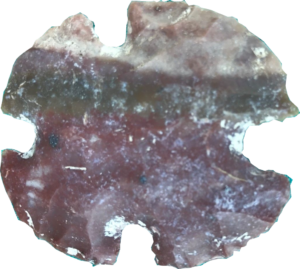
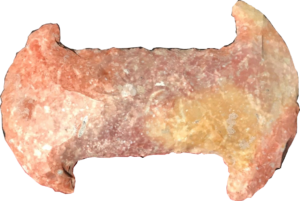 (79a) – Double Cross Shape (79b) – Double Axe Shape
(79a) – Double Cross Shape (79b) – Double Axe Shape
Cave Art & Petroglyphs
Some of the oldest cave paintings in the world, are said to date to approximately 40,000 years ago. In the Kimberly region of Western Australia, there are caves which have animal depictions dating back 40,000 years called the Bradshaw artworks (1a).
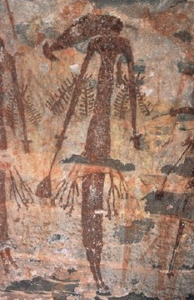 (1a) Bradshaw Art, Australia c. 45,000-15,000 BC
(1a) Bradshaw Art, Australia c. 45,000-15,000 BC
Some paleontologists and archaeologists have dated these at 40-45,000 years old and others, closer to 15-22,000 years old. Either way, the scenes depict clear hallucinatory images which we now recognize as shamanic. These strange looking creatures have what appear to be mushrooms coming out of their heads and hands in some places, though many of the images do not depict this clearly just yet.
(23) Russell, Shamanism and Drug Propaganda, p.11; Oakley’s Man, the Tool Maker, 1959, cited in Sherwood Washburn, Social Life of Early Man, 1961
Page 4
Bigge Island, Kimberly, Australia, is host to a mushroom art glyph said to be dated to 35,000 BC (1b). Also, in the Laura-Quinkan, Queensland, Australia, area resides a piece of cave art estimated to be from the 30,000-15,000 BC era, depicting mushroom headed people (1c). At the Kakadu National Park in the Northern Territory of Australia, dating back to 6000 BC, there are numerous mushroom-headed people depicted (2c).
 (1b) Bigge Island, Kimberly, Australia. c. 35,000 BC
(1b) Bigge Island, Kimberly, Australia. c. 35,000 BC
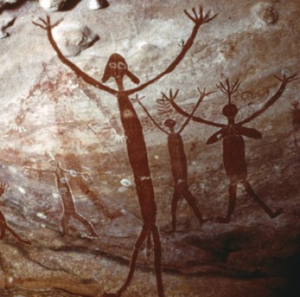 (1c) Laura-Quinkan, Queensland, Australia c. 30,000-15,000 BC
(1c) Laura-Quinkan, Queensland, Australia c. 30,000-15,000 BC

(2c) Kakadu National Park, Australia c. 6000 BC
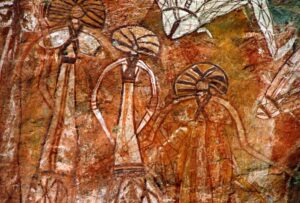 (2c) Kakadu National Park, Australia c. 6000 BC
(2c) Kakadu National Park, Australia c. 6000 BC
Close to 3500-4000 years ago, the Wandjina artwork appears in Australia, which is full of mushroom symbolism (1e, f, g; 2a, b). This is where we get lots of images which some have claimed to be “ancient astronauts” or extraterrestrials. These images clearly depict mushroom populations, and enlightened “consciousness.” One of the reasons I believe these are mushrooms is because there are related depictions of these same people as multiple “spores,” and these are not people, but mushroom populations (2e). As well, there are depictions which look just like mushroom caps (2a).
 (1e) Wandjina Art, Australia c. 2000-1500 BC
(1e) Wandjina Art, Australia c. 2000-1500 BC
Page 5
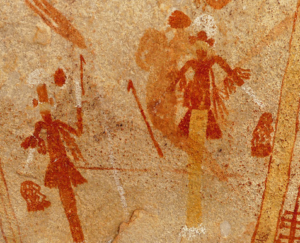 (1d) Mitchell River, Queensland, Australia
(1d) Mitchell River, Queensland, Australia
Tassili n’Ajjer in the Sahara Desert in southeast Algeria, contains depictions of mushrooms which are said to date to approximately 10,000 BC. The shamanic nature of the artwork is clearly evident in some of the images at Tassili, where animal transmorphic art depicts human shaped animals or beast people with mushrooms emerging from them (4a), as well as images of mushroom headed people standing next to bulls (4e).
More frequently, mushroom-headed “people” are seen dancing around, which is a common depiction on cave art all over the world. This fact alone indicates that either there was one group of humans who went around the world spreading this knowledge through cave systems or this thought evolved spontaneously like the hundredth monkey all over the world during a common era. The other common depiction on this early cave art are horned animals, more commonly steer, such as bulls or cows. There is a preponderance of these in much of the early Tassili artwork. We also have artwork from Tassili which depicts humans riding a two-wheeled cart being driven by an animal, likely a deer. It could also be a horse, but the drawing appears to have small horns placed on the head. It’s difficult to say which animal it is for certain. What is clear is that there are wheels on the cart, and it’s being driven by an animal. It is from Cucuteni (Romanian/Ukrainian) pottery, c. 3900 BC, where we get the first evidence of wheeled vehicles in the form of a bull with wheels on it being depicted, and previously, it was assumed by some scholars that this was the beginning of the horse-drawn chariot. (24) Clearly, the cave depiction from Tassili are far older.
In Chad, in north central Africa, at the Ennedi Plateau, there are rock engravings thoughts to be as old as 12,000 years or more and cave art dating from 4000-9000 years back. Several of these images depict mushroom headed people standing next to cows or bulls (7a). There are also depictions of camels and birds as well, and it’s apparent that culture had evolved quite a bit. The mushroom grows from the bull and cow dung as well as other bovine animals. This relationship of early man to the bovine species is the central key to understanding the mushroom’s influence upon world religions. In America we have a very nice example of the bull or cows and the mushroom together (7e).
 (7a) Ennedi Plateau, Chad c. 7000-2000 BC
(7a) Ennedi Plateau, Chad c. 7000-2000 BC
(24) Russell, Shamanism and Drug Propaganda, p.46
Page 7
The stag-man, or early shaman figures prominently in ancient cave art and is most popularly portrayed in the Altamira caves of Cantabria, Spain and in the Cavern des Trois Freres at Ariege in the French Pyrenees, which date from approximately 20,000 BC (25). Also, at Altamira, Spain, there exists cave art depicting bulls and bison that date to 20,000 years ago. One particular image which I believe is from Altamira depicts a mushroom headed figure with one mushroom hand and a serpent’s tail for another hand, along with a serpent’s tail as legs (5a). The date I have for this image is 35,000 years ago, but this is not verified by me, nor is the location just yet. Regardless of its exact date and location, this image is likely the first known drawing to portray the presence of the serpent and mushroom combined in one image. This will become a very frequent theme in the future of ancient art, as we will see.
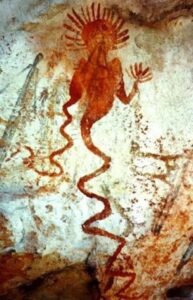 (5a) Altamira Caves, Spain c. 34,000 BC
(5a) Altamira Caves, Spain c. 34,000 BC
The Selva Pascuala mural exists in a cave near the town of Villar del Humo, in Spain, and is thought to date c. 4000 BC. The cave mural has an image of a cow and a row of mushrooms which look very similar to a psilocybin variety (7c).
Russian Archaeologist N.N. Dikov, from Siberia, in 1967-68, first discovered mushroom petroglyphs on the eastern bank of the Pegtymel River. Mushroom headed people are portrayed along with reindeer, wolves, and fish (7g). It is estimated so far, that these were painted from the end of the Stone Age to the beginning of the Bronze Age (8000 BC – 1000 BC). (26) This is quite a span of time to speculate on, but I suppose it gives room for error. I would speculate that they are possibly ten thousand years old or more. They represent a very primitive lifestyle and association with nature, which, when compared to similar petroglyph from other areas around the world, bring us to a date closer to 10,000 BC.
 (7g) Near the Eastern bank of the Pegtymel River in Siberia c. 8000-1000 BC
(7g) Near the Eastern bank of the Pegtymel River in Siberia c. 8000-1000 BC
In Khakassia, Siberia, there are petroglyphs which date to 3000 BC, which are said to have been made by Turkish people who were inhabiting Siberia at the time (6b). These images depict “menorah-mushroom” headed people for the first time and suggest to us that the mushroom influenced the design which later became the menorah in Hebrew tradition. There is also art from southern Siberia, from the Оkunev culture dating back to the 2nd century BC (6f), which depicts similar artwork to the Wandjina art in Australia portraying a mushroom deity with a halo or what some might call “sun rays” emanating around the head area. This is very common on early cave art. There is also similar art found in Toro Muerto, Peru which date back approximately 12-14,000 years (7i).
(25) The White Goddess: A Historical Grammar of Poetic Myth, Robert Graves, McGraw, Hill, 1966 (1948), p. 217
(26) Persephone’s Quest – Wasson, Ott, Ruck, Kramrisch, Yale University Press, 1986. P.68
Page 8
 (6b) Khakassia, Siberia c. 3000 BC
(6b) Khakassia, Siberia c. 3000 BC
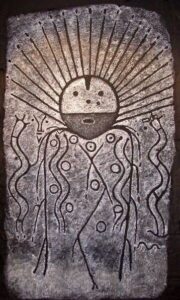 (6f) Southern Siberia, Оkunev culture, c. 200-100 BC
(6f) Southern Siberia, Оkunev culture, c. 200-100 BC
 (7i) Toro Muerto, Peru c. 12000-10,000 BC
(7i) Toro Muerto, Peru c. 12000-10,000 BC
In the Val Camonica part of Italy, similar cave art can also be found and many “ancient astronaut” believers like to point to this one piece as evidence that “spacemen” were here in Earth’s distant past (7f). Likewise, we see similar images portrayed on glyph art from Keep River National Park, Australia (2d).
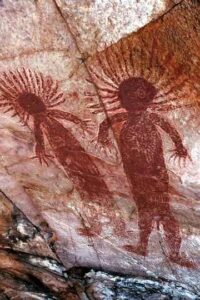 (2d) Keep River National Park, Australia
(2d) Keep River National Park, Australia
When one compares all these images and sees the mushroom influence alongside it all, it should be clear to anyone viewing these that they are entheogenic related images and not ancient astronauts. Though the artists were likely experienced psychonauts, themselves exploring “inner space.” What some people refer to as ancient astronaut “helmets” and others refer to as “sun rays,” I see as halos or auras of consciousness or enlightenment. In other words, “illumination.”
In the US, there are numerous states which have rock petroglyphs which date back to pre-Columbian times, more likely to the late Stone Age. Most experts agree that the rock glyphs in the USA date from 100 AD to 1400 AD, however, I suspect some of them are far older. A primitive style mushroom glyph appear in Dinwoody, WY. In Dry Fork Canyon, Ut., there is a shaman figure with a mushroom hanging off of his elbow (5d) and in McKee Springs, Ut., there is a similar image of a figure is holding a mushroom (5c).
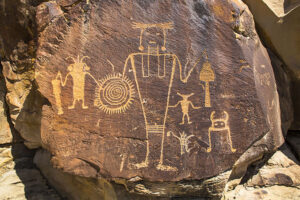 (5c) McKee Springs, Dinosaur National Monument, Utah c. 100 -1300 AD
(5c) McKee Springs, Dinosaur National Monument, Utah c. 100 -1300 AD
Page 9
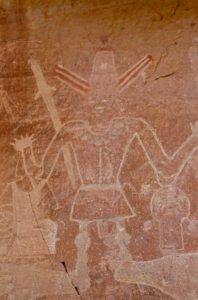 (5d) Dry Fork Canyon, Utah c. 100 – 1300 AD
(5d) Dry Fork Canyon, Utah c. 100 – 1300 AD
In Monticello, Ut., there is a mushroom personified with arms and a head (5b) and in Albuquerque, N.M., at Petroglyph Monument, there is an mushroom-like creature sitting against a rock, with what appear to be antennae popping out from his head (3c), as well as a couple of mushroom figures which are well occulted (3f, k, h).
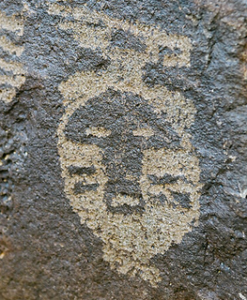 (3f) Petroglyph National Monument, NM
(3f) Petroglyph National Monument, NM
 (3h) Petroglyph National Monument, NM
(3h) Petroglyph National Monument, NM
There is also a serpent with horns at Petroglyph National Monument, next to another serpent with a mushroom head, indicating the possibility that both of these are occulted mushrooms (4c). There is another image similar to this in the US as well (4d). They appear to be mushroom headed serpents (4f, g).
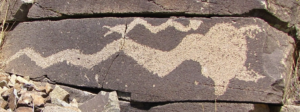 (4c) Petroglyph Hill, N.M.
(4c) Petroglyph Hill, N.M.
Page 10
The reader should take notice here of some of the methods of occulted symbolism used in the ancient glyph art. In the following images one can see how the mushroom was made a part of the body of the deity being pictured. At Horseshoe Barrier Canyon Utah, we see the classic thunderbird of Native American lore (3a). This is an image of a mushroom as the bird goddess as she is also depicted in glyphs throughout New Mexico (3b, e, g, j). This same bird goddess is depicted at Lower Pecos River, Seminole Canyon State Park and Historic Site, Comstock, Texas, dated to an estimated 2500 BC (6e), as well as glyphs from Desolation Canyon Utah dated from 100 to 1300 AD (6d). This mushroom/bird goddess can also be found in Siberia (6a) and Saudi Arabia (6c).
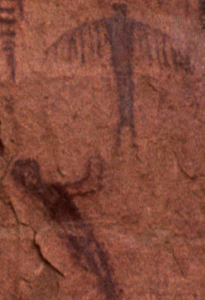 (3a) Horseshoe Barrier Canyon Utah
(3a) Horseshoe Barrier Canyon Utah

